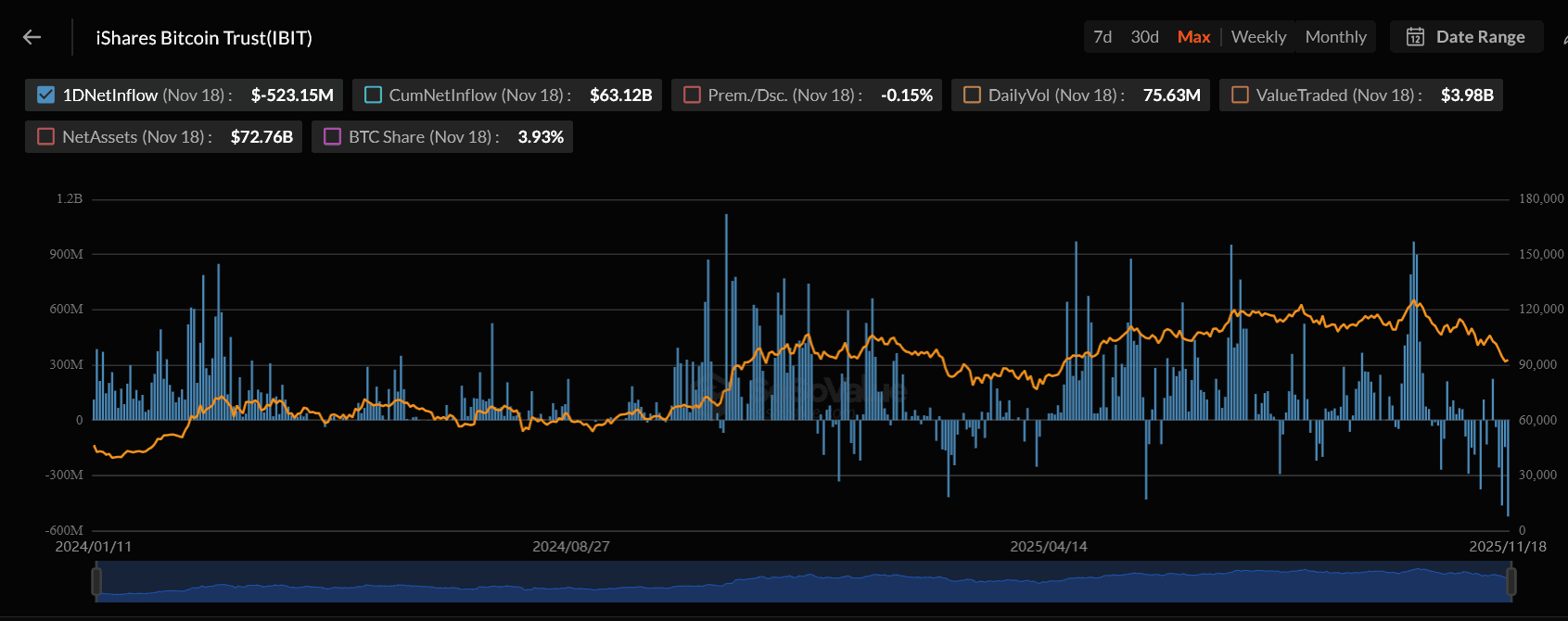BlackRock’s Bitcoin ETF Just Logged a Record Outflow
BlackRock’s iShares Bitcoin Trust (IBIT) saw the largest daily net outflow since its launch: $523.15 million leaving in a single day. That figure even beat the previous outflow record set earlier this month. It also capped off five consecutive days of withdrawals that now total $1.43 billion.
IBIT is still the biggest spot bitcoin ETF i n the world, sitting on more than $72 billion in assets, but the tone has shifted. Over the past four weeks, the fund has posted continuous net outflows worth $2.19 billion, lining up almost perfectly with bitcoin’s sharp pullback from its $126,080 all-time high down to below $90,000 earlier this week.
In other words, institutions aren’t dumping bitcoin outright. They’re lightening the load while macro signals remain noisy.
Are Institutions Really Leaving Bitcoin?

Not exactly. Vincent Liu, CIO at Kronos Research, put it plainly: this is recalibration, not capitulation. Big allocators are clipping risk and waiting for clarity. With the U.S. government finally reopening after a prolonged shutdown and the market staring at a December Fed decision that could swing everything, investors are simply protecting themselves.
Bitcoin is already responding with a modest bounce back above $91,000, but liquidity remains tight. The CME’s FedWatch Tool currently shows about a 49 percent chance of a 25-basis-point rate cut next month. Until that becomes more decisive, institutions will probably keep trimming rather than adding.
Also worth noting: IBIT’s giant outflows erased inflows from Grayscale and Franklin Templeton’s bitcoin funds, leaving the entire spot BTC ETF market at a net $372.7 million outflow for the day. Even Ethereum ETFs followed the same script, with BlackRock’s ETHA losing $165 million despite smaller inflows elsewhere.
While Bitcoin Bleeds, Solana ETFs Are Quietly Winning
Now here’s the twist: while bitcoin ETFs are seeing red, Solana ETFs are glowing green.
Tuesday marked the launch of Fidelity’s FSOL and Canary Capital’s SOLC. FSOL pulled in $2.07 million on day one. SOLC saw no flows. But the real action came from the early players:
- Bitwise’s BSOL: $23 million inflows
- Grayscale’s GSOL: $3.19 million inflows
Since BSOL launched on October 28, Solana ETFs have posted 16 straight days of net inflows, totaling $420.4 million.
That streak tells a bigger story. Investors are exploring altcoins that offer yield, activity, and momentum while bitcoin cools off. Liu captures it neatly: Solana is one of the freshest ETFs in the market, and the bundled staking exposure is pulling in a different class of investors—people who want upside plus productive assets.
What About XRP, Litecoin, and Hedera ETFs?
Canary Capital’s spot XRP ETF added $8.32 million on Tuesday, showing steady demand.
Meanwhile, its Litecoin ETF and Hedera ETF didn’t see any flows.
It doesn’t reflect rejection; it reflects attention gravity. Right now, Solana is the hot trade, bitcoin is in risk-off mode, and the rest of the market is waiting for direction.
IBIT’s record outflow is a flashing headline, but not a panic signal. Institutions are moderating exposure until macro conditions settle. Bitcoin remains the anchor, but Solana is the one quietly stealing the spotlight.
If liquidity improves and the Fed leans dovish in December, this entire dynamic could flip again. For now, the rotation tells the real story: capital isn’t leaving crypto—it’s moving around inside it
Disclaimer: The content of this article solely reflects the author's opinion and does not represent the platform in any capacity. This article is not intended to serve as a reference for making investment decisions.
You may also like
Bitcoin News Update: Yen’s Decline Tests Bitcoin’s Risk Appetite Link as Fiscal Pressures Mount
- Japanese yen's 10-month low against the dollar sparks debate on Bitcoin's risk-on correlation amid divergent monetary policies. - Japan's ¥14 trillion fiscal package aims to boost liquidity but raises concerns over 240% debt-to-GDP ratio and rising bond yields. - Swiss franc emerges as new risk barometer as yen's carry trade faces strain from higher yields and potential capital outflows. - Bitcoin struggles to hold $92,000 support amid weak institutional demand and ETF inflows, with November bond auction

Fed Focuses on Curbing Inflation Instead of Stimulus, Postpones Interest Rate Reductions
- JPMorgan withdraws December Fed rate-cut forecast as market odds drop below 50%, reflecting uncertainty over central bank easing timelines. - Gold and Bitcoin decline amid "risk-off" sentiment, with traders scaling back bets on Fed accommodation and asset prices adjusting to prolonged high rates. - Fed officials emphasize cautious approach to inflation control, prioritizing labor market stability over premature cuts, with 2025 easing limited to one or two 25-basis-point reductions. - Internal Fed divisio

Bitcoin Updates Today: ABTC's Bold Bitcoin Strategy: Will the Hybrid Approach Surpass Market Fluctuations?
- American Bitcoin Corp. (ABTC) aims to scale to 50 EH/s hashing capacity via a hybrid model combining mining and Bitcoin treasury growth, leveraging a 2025 reverse merger with Hut 8’s Gryphon Digital Mining. - The merger, backed by Trump affiliates, enables ABTC to acquire Bitcoin at half market cost, driving Q3 2025 revenue growth to $64.2M with 56% gross margin from energy-efficient mining operations. - Risks include Bitcoin price volatility (noted $5.5M Q3 losses) and rising competition for affordable

Bitcoin Update: Crypto Market Plunges Amid Fed Policy Ambiguity and Data Void
- Bitcoin fell below $86,000 in late November 2025 as delayed U.S. jobs data and Fed policy uncertainty triggered a crypto sell-off. - BLS delayed October employment figures and November report, reducing December rate cut odds to 33% and eroding market clarity. - Fed internal divisions and a "data black hole" intensified volatility, with Ethereum and major cryptos losing 5-12% in 24 hours. - Fiscal acceleration and Trump tax-cut bill added complexity, while crypto liquidations hit $443M and stablecoin issu

